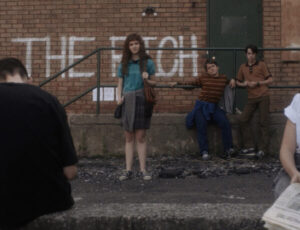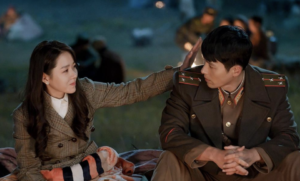Shane Carruth’s Upstream Color begins with the impressionistic observation of a fictional drug sub-culture involving parasites (or symbiotes) that, either through consumption or infection, induce a kind of telepathic empathy between humans. It’s a beautiful, lingering sequence that drifts from moment to moment in shallow focus, showing us a man (Thiago Martins) harvesting the worms under the roots of orchids, before moving on to teenage users drinking a tea brewed from the organism or the infected flowers to perform an unrehearsed, empathic dance. It’s the beauty of beginnings: of discovery and creation. This prologue is followed by a sequence that shows us the perversion of that beauty. The man harvesting the worm (known simply as Thief in the credits) kidnaps and infects a woman, Kris (Amy Seimitz, effective), with the organism. Using the effects of the worm and a variety of mind-control techniques to hypnotize and control her for what seems like two days, the Thief gets Kris to sign away her money in cheques, and leaves her with a life in ruins and an invasive organism inside her.
These two opening acts are distancing but fascinating, delivering exposition (the existence of the drug/organism and its proliferation) and plot (the infection and destabilizing of Kris’ life) with a precision that belies Carruth’s disorienting editing, and that too with barely any dialogue. But things get even more intriguing, less rewarding and more frustrating with the appearance of a man known as the Sampler (Andrew Sensenig)–who infects pigs with the worms surgically removed from victims like Kris for an ill-defined experiment–and Jeff, another victim of the infection-scam (played with slightly wooden weariness by Carruth himself). When Jeff and Kris are drawn together, it becomes clear that they’re telepathically connected to both the pigs and each other because they’ve hosted the organism, which pervades the biosphere and draws together disparate people and elements into a confused, hazy hive-mind. It’s hard to discuss the plot further without giving too much away, so I won’t. Suffice to say that there is a romance at the heart of it, but it’s rather shallowly depicted, ruled by the impositions of said plot rather than the two people we follow through it. Kris and Jeff are defined by the organism’s effect of their lives, and little else. Though the moments Carruth captures of their telepathically destined courtship look and sound lovely (the score very effectively unifies the film’s disjointed pieces with its thrumming, hypnotic overlay), there’s no heart to them because we don’t know them, and they seem more confused and irritated by their attraction than anything else.
What ultimately keeps this gorgeously lensed and masterfully edited film from being as successful as similarly oblique audiovisual thought-experiments is that it seems, for something so dreamily told and dismissive of narrative norms and constraints, too deliberately constructed. It’s clear that Carruth knows exactly what’s going on in the film, knows what’s behind every confusing omission of narrative and odd scenic non-sequitur. Many have observed that Carruth’s switched here from the restrained sterility of his debut Primer (2004) to a style reminiscent of Terrence Malick’s free-roaming cinematic odes to beauty. This isn’t inaccurate. But Upstream Color doesn’t feel interpretive in the manner of, say, Malick’s self-indulgent masterpiece The Tree of Life (2011), a film so diffuse in its ecstatic spiritual exploration that it’s entirely open to different ideas of what the meaning of its presented images and sounds is. Nor does Carruth’s film effectively tell the story it wants to (something The Tree of Life didn’t have to do because it was barely interested in telling one), as Harmony Korine’s also-Malickian Spring Breakers (2013) does with a bold simplicity that allows its poeticism to take precedence.
The problem here is that Carruth doesn’t let the undeniable poeticism of his film take precedence. He instead litters it with cues indicating that beneath the obfuscating layer of beautifully composed stream-of-consciousness imagery and aural dreamscapes lies an actual plot that matters. And the fact is, there is a discernible plot here, and it’s science-fictionally strange but far from incomprehensible. But the abstract way in which Carruth tells his story makes it seem convoluted and vague in a way that becomes distancing and often tiresome. As a result, instead of letting the tactility of the film wash over me in the way I’d allow others of its ilk (Tarkovsky’s films also come to mind), I was too busy trying to figure out what was going on, and feeling like I was missing something whenever I lost the tangled threads of Carruth’s meandering narrative.
By consciously evoking Henry David Thoreau’s transcendentalist narrative Walden several times, Carruth appears to nudge viewers into seeing humanity’s existence within nature (as represented by the organism and its presence throughout the biosphere) as troubled and even delusional, but romantic in the way the most difficult relationships are. Walden is used, after all, as a tool for brainwashing by the Thief. Carruth’s depiction of a population under the grip of a dreaming, changing infection coursing through an ecosystem is haunting. But the film’s thematic undercurrents are muddled, not coalescing in a way that gives the film’s aesthetic achievements a significant heft during the viewing of the film. Once it’s over, it’s all plenty thought-provoking, and rich in thematic weight to be unravelled. For example, there’s much to be said of the incipient body horror in this otherwise lyrical film, tied up in the way that the organism hijacks Kris’ human reproductive abilities and also acts as the ghost of a pregnancy. That’s only scratching the surface. The film’s worth its weight in interpretive essays. But it doesn’t change the fact that the actual experience of watching it yields less rewards than thinking about it after. For me, at least.
The chief pleasures of the film are textural–its lush digital cinematography and rhythmic editing, its occasionally striking compositions, its sound design and scoring (Carruth was involved in all these aspects, as well as directing and writing), all evoke the intensity of intimate poetry or the tactile lucidity of a drug trip. But Upstream Color feels like a tone poem used to tell a novel-length, philosophical science-fiction story, and I’m not convinced that Carruth effectively unites these two tendencies. There’s no doubting that he’s a talent to watch, and that his use of low-budget film-making and self-distribution to deliver a vision that’s unique and completely unlike studio features is highly admirable. I can only encourage such verve from an independent filmmaker. If nothing else, Upstream Color has already gotten people thinking and talking about it, and with reason. A film that provokes this kind of debate and discussion is already worth more than a generic retread of billion-dollar tropes.
UPSTREAM COLOR
USA 2013. Director: Shane Carruth
96 mins.








